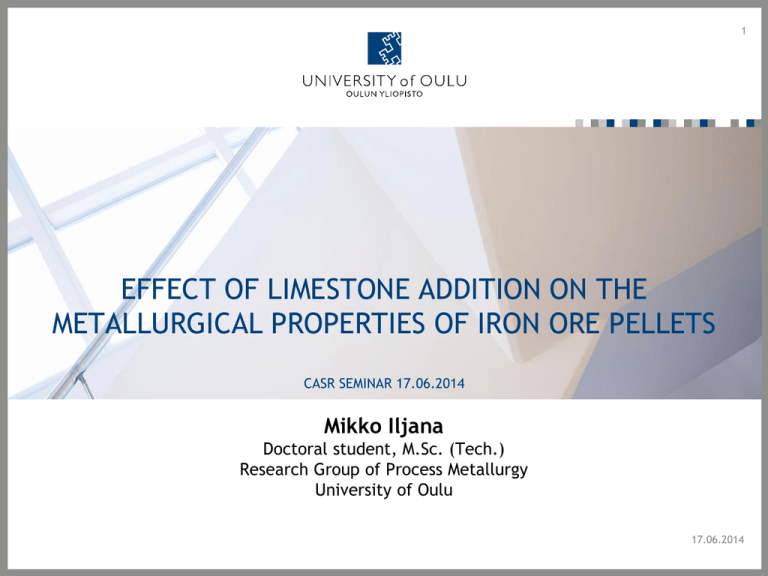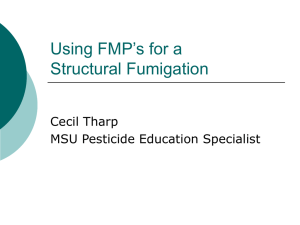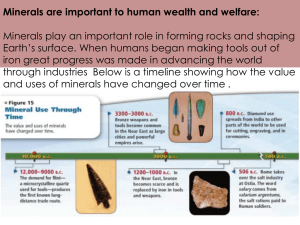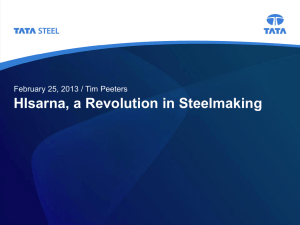Reducibility and reduction swelling behaviour of some iron
advertisement

1 EFFECT OF LIMESTONE ADDITION ON THE METALLURGICAL PROPERTIES OF IRON ORE PELLETS CASR SEMINAR 17.06.2014 Mikko Iljana Doctoral student, M.Sc. (Tech.) Research Group of Process Metallurgy University of Oulu 17.06.2014 CONTENTS • Background • Introduction • Materials Non-fluxed iron ore pellets Limestone fluxed iron ore pellets • Methods / metallurgical tests Reducibility Reduction swelling behaviour Reduction-softening (ARUL) Cold crushing strength (CCS) Low-temperature disintegration (LTD) • Results • Discussion Limitations of the research • Conclusions FACULTY OF TECHNOLOGY / Research Group of Process Metallurgy / Mikko Iljana 17.06.2014 2 BACKGROUND • This presentation is based on a manuscript Effect of Limestone Addition on the Metallurgical Properties of Iron Ore Pellets by Mikko Iljana a, Antti Kemppainen a, Timo Paananen b, Olli Mattila b, Erkki Pisilä b, Mikhail Kondrakov c and Timo Fabritius a submitted to the International Journal of Mineral Processing on 31th May 2014. Research Group of Process Metallurgy, University of Oulu, Finland b Ruukki Metals Oy, Raahe, Finland c Karelsky Okatysh, Severstal Resources, Kostomuksha, Russia a • The manuscript will be the third article in my doctoral thesis. • Published articles: Article I: Iljana M, Mattila O, Alatarvas T, Visuri V, Kurikkala J, Paananen T & Fabritius T (2012) Dynamic and Isothermal Reduction Swelling Behaviour of Olivine and Acid Iron Ore Pellets under Simulated Blast Furnace Shaft Conditions. ISIJ Int 52(7): 1257–1265. Article II: Iljana M, Mattila O, Alatarvas T, Kurikkala J, Paananen T & Fabritius T (2013) Effect of Circulating Elements on the Dynamic Reduction Swelling Behaviour of Olivine and Acid Iron Ore Pellets under Simulated Blast Furnace Shaft Conditions. ISIJ Int 53(3): 419–426. FACULTY OF TECHNOLOGY / Research Group of Process Metallurgy / Mikko Iljana 17.06.2014 3 4 INTRODUCTION • Iron ore pellets are used for the production of hot metal in blast furnaces and DRI/HBI in direct reduction processes. • A blast furnace is a shaft furnace, which is charged with iron bearing materials (pellets, sinters and/or lump ore), reducing agents (metallurgical coke) and additives (limestone, quartz, BOF slag). Metallurgical coke and auxiliary reducing agents (coal, oil, natural gas) are used to reduce iron oxides and melt the charge materials. • Main types of pellets Acid Basic Fluxed • Some additives are often used to make better the metallurgical properties (reducibility, softening and melting properties, slag formation) of the iron ore pellets Limestone CaCO3 Magnesite MgCO3 Dolomite (Ca,Mg)CO3 Olivine Mg2SiO4 • In this study, the focus is on limestone as an additive. • There are a lot of standard tests for iron ore pellets. Additionally steel companies and specialized research institutes have their own tests. HBI = Hot Briquetted Iron DRI = Direct Reduced Iron FACULTY OF TECHNOLOGY / Research Group of Process Metallurgy / Mikko Iljana 17.06.2014 5 MATERIALS • Iron ore pellets were manufactured by Severstal Resources in Karelia (Russia). • Not commercial grade, but test pellets produced in a laboratory-scale pelletizing drum and fired in sample baskets in the same production line as the commercial blast furnace pellets. • “Non-fluxed” and “fluxed” with similar SiO2 content. Chemical analysis Size distribution Internal structure (LOM image) Non-fluxed FACULTY OF TECHNOLOGY / Research Group of Process Metallurgy / Mikko Iljana 17.06.2014 Fluxed METALLURGICAL TESTS FOR IRON ORE PELLETS Standard tests Modified tests Isothermal Dynamic Max. 1100oC Reduction swelling behaviour (without load in the shaft area) Low-temperature disintegration, LTD, ISO 13930 (disintegration as hematite reduces to magnetite at the top of the shaft) Max. 1100oC 500oC FACULTY OF TECHNOLOGY / Research Group of Process Metallurgy / Mikko Iljana Advanced Reduction under Load, ARUL (temperature and reduction degree in the cohesive zone) Max. 1100−1350oC 17.06.2014 Oulu University 25oC Reducibility (without load in the shaft area) Ruukki Metals Ruukki Metals Cold Crushing Strength, CCS, ISO 4700 (handling, charging, screening) 6 7 TESTS CARRIED OUT IN OULU UNIVERSITY • Reducibility test: • Total of 26 pellets • Total weight: 120 g • Size: 12.5–16 mm • Well-fired pellets with nil to small-sized magnetite nucleus • ”No additives” test (CO-CO2-N2 gas) • Reduction swelling test: • 2 pellets of a certain grade, total of 4 pellet grades • • • • Weight: 4.7±0.2 g (each pellet) Size: 12.5–16 mm Round-shaped Well-fired pellets with nil to small-sized magnetite nucleus • ”No additives”, ”Medium-S” and ”High-K” tests FACULTY OF TECHNOLOGY / Research Group of Process Metallurgy / Mikko Iljana 17.06.2014 BLAST FURNACE GAS PHASE SIMULATOR (BFS) 8 Unique laboratory device to test the effect of S2(g) and K(g) Furnace 1 Reduction tube 2 Sample basket 3 Thermocouple 4 Electrically heated furnace 5 Gas inlet 6 Transparent lid with cooling gas inlet and reducing gas outlet Gas supply system 7 Gas containers 8 Mass flow controllers 9 Potassium generator 10 Sulphur generator 11 Water vapour generator • Reduction tube with inner diameter of 95 mm • Adjustable partial pressures of N2, CO, CO2, H2, H2O, S2 and K gases • Time-temperature dependent atmosphere profiles • Heat resistant steel tube (max. T 1100 oC) • Online measurement of sample weight • Camera recording system • Inert purging gas (N2) to cool the sample quickly • Many variables can be studied at the same time Camera redording system 12 Light source 13 Mirror 14 Camera Auxiliary instruments 15 Scale for TGA 16 Computer system FACULTY OF TECHNOLOGY / Research Group of Process Metallurgy / Mikko Iljana 17.06.2014 Potassium generator: K2CO3(s) + 2C(s) = 2K(g) + 3CO(g) Sulphur generator: 2SO2(g) + 2C(s) = S2(g) + 2CO2(g) REDUCTION CONDITIONS (1/2) • Reduction conditions (temperature and gas composition) in the blast furnace shaft were simulated • CO-CO2-N2 gas (”No additives” test) • From ambient temperature (25oC) up to 1100oC • Gas composition was also adjusted during the tests. • Total gas flow rate 10 l/min ”No additives” experiment FACULTY OF TECHNOLOGY / Research Group of Process Metallurgy / Mikko Iljana 17.06.2014 9 10 REDUCTION CONDITIONS (2/2) • Effect of gaseous sulphur and potassium on the swelling was also studied. o ”Medium-S” test with COCO2-N2–S gas max 0.1 vol-% S(g) o ”High-K” test with COCO2-N2–K gas max. 0.03 vol-% K(g) • The circulation of S and K in the BF shaft were simulated. FACULTY OF TECHNOLOGY / Research Group of Process Metallurgy / Mikko Iljana 17.06.2014 REDUCIBILITY AND REDUCTION SWELLING BEHAVIOUR • Reducibility test: Non-fluxed: 59.4 % RD Fluxed 63.5 % RD • Reduction swelling test: RD = Reduction Degree RSI = Reduction Swelling Index FACULTY OF TECHNOLOGY / Research Group of Process Metallurgy / Mikko Iljana 17.06.2014 11 12 REDUCTION-SOFTENING TEST (ARUL) Wüstite Metallic iron FACULTY OF TECHNOLOGY / Research Group of Process Metallurgy / Mikko Iljana 17.06.2014 13 CONDITIONS IN THE ARUL EXPERIMENTS • Initial sample H 90 mm and D 70 mm (W ~600−700 g) • BF conditions are simulated under CO-CO2-N2 gas • Total gas flow 23 l/min • The test is ended as the pressure difference across the sample exceeds 70 mbar or temperature rises up to 1350oC (=cohesive zone). Note that the conditions are similar to the reducibility and reduction swelling tests up to 1100oC! FACULTY OF TECHNOLOGY / Research Group of Process Metallurgy / Mikko Iljana 17.06.2014 14 SOFTENING BEHAVIOR (ARUL) • In the top part of the ARUL sample pellets are somewhat flattened themselves due to the load showing softened structure. • At the end of the ARUL experiment, melt has started to squeeze through the top holes in the graphite crucible. Cross-sections • The lower part is better reduced than the upper part. • The periphery of individual pellets is better reduced than the core. Light grey: metallic iron Dark grey: wüstite FACULTY OF TECHNOLOGY / Research Group of Process Metallurgy / Mikko Iljana 17.06.2014 SOFTENING BEHAVIOR (ARUL) • Pressure difference curve indicates the ability of gases to penetrate through the pellet cake. • TDP20, TDP50 and TDP70 values are temperature when pressure difference across the sample is 20, 50 and 70 mbar. • Fluxed pellets started to soften at lower temperatures, however the final reduction degree was higher compared to the non-fluxed pellets. FACULTY OF TECHNOLOGY / Research Group of Process Metallurgy / Mikko Iljana 17.06.2014 15 MICROSCOPIC STUDIES (FESEM-EDS) Non-fluxed Fluxed Wüstite Metallic iron Inter-granular slag (olivine) • The reason for forming gas impermeable structure is apparently linked to the increase of inter-particle melt with olivine composition allowing wüstite grains to move in relation to each other under the mechanical stress. FACULTY OF TECHNOLOGY / Research Group of Process Metallurgy / Mikko Iljana 17.06.2014 16 17 PHASE DIAGRAM EXAMINATION • Chemical composition of the inter-granular slag was plotted to the composition section of 2CaO·SiO2−2FeO·SiO2 Non-fluxed Fluxed Minimum eutectic temperature (1115oC) • Hypothesis: In the fluxed pellets, primary slag with composition near eutectic liquid has formed in the ARUL experiment and the composition of the primary slag has changed to contain less FeO due to reduction reactions proceeding during softening. FACULTY OF TECHNOLOGY / Research Group of Process Metallurgy / Mikko Iljana 17.06.2014 COLD CRUSHING STRENGTH AND LOW-TEMPERATURE DISINTEGRATION • The LTD value indicates the percentage of the +6.3 mm fraction after stressing the pellet sample isothermally at 500oC in a CO-CO2-H2-N2 gas. • “Recommendations” for blast furnace use: CCS > 220 daN LTD > 55 % • Limestone addition slightly decreased the “quality indexes” CCS and LTD. • However, the CCS and the LTD values for the fluxed pellets are estimated to be enough high for blast furnace use. • Discussion: Effect of divalent iron content FACULTY OF TECHNOLOGY / Research Group of Process Metallurgy / Mikko Iljana 17.06.2014 18 19 DISCUSSION • Blast furnace burden materials have strict requirements All metallurgical “quality indexes” must be at acceptable level • In a real blast furnace also other slag forming elements, such as alkalis, sulphur and ash particles from metallurgical coke and alternative reducing agents, are captured by iron ore materials. The effect of alkalis, sulphur and ash particles to inter-granular slag formation was not taken into account in the softening test (ARUL). Possible problems may arise from the high sulphur load leading to partial melt formation of FeO-FeS at temperatures higher of 915oC. • The numerical results of ARUL experiments cannot be taken as direct measure of the softening temperature of the iron-bearing charge in a real blast furnace, but it shows the difference between different burden materials (=suitable for comparative studies). FACULTY OF TECHNOLOGY / Research Group of Process Metallurgy / Mikko Iljana 17.06.2014 20 CONCLUSIONS • Limestone addition increased the reducibility of the pellets. • Swelling and cracking of the pellets during dynamic reduction was slightly increased with limestone addition. • The final reduction degree was higher in the reduction-softening test named ARUL with the fluxed pellets compared to the non-fluxed ones, although softening began in a lower temperature with the fluxed pellets compared to the non-fluxed ones. • Limestone addition slightly decreased the cold crushing strength of the acid pellets and increased the fines formation in the hematite to magnetite reduction stage in the LTD test. However, the CCS and the LTD values for the fluxed pellets are estimated to be high enough for blast furnace use. FACULTY OF TECHNOLOGY / Research Group of Process Metallurgy / Mikko Iljana 17.06.2014 21 Thank You for Your Interest! Now is Time for Questions! Mikko Iljana Doctoral student, M.Sc. (Tech.) Mikko.Iljana(at)oulu.fi Research Group of Process Metallurgy University of Oulu FACULTY OF TECHNOLOGY / Research Group of Process Metallurgy / Mikko Iljana 17.06.2014






